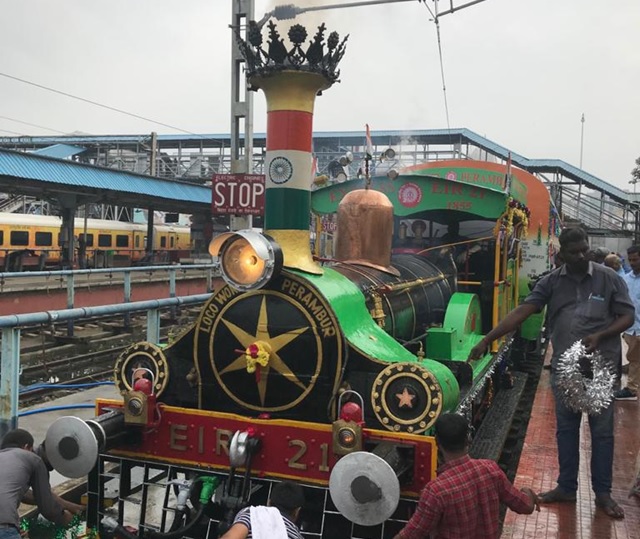Rail Heritage
It's Time to Start Your Adventures

Epic Journeys on World Heritage Railways
For rail buffs, India offers a historic railway terminus and three mountain railways designated as UNESCO World Heritage sites. This includes the Chattrapati Shivaji Terminus in Mumbai; the Darjeeling Himalayan Railway in West Bengal; the Nilgiri Mountain Railway in Tamil Nadu and the Kalka– Shimla Railway in Himachal Pradesh. These three railways have been chosen for “outstanding examples of bold, ingenious engineering solutions… through rugged, mountainous terrain.” The historic steam engines on these routes are popularly known as ‘Toy Trains’ because of their miniature designs. They travel at a leisurely pace along mountain trails, allowing passengers to admire the scenic landscape.

Kalka - Shimla Railway
This narrow-gauge line connecting Kalka in the Himalayan foothills to Shimla, the former summer capital of British India, was opened in 1903. The railway line has 103 tunnels and 864 bridges built like Roman aqueducts to carry the train across the deep ravines providing spectacular views. The narrow gauge Kalka-Shimla railway runs between Kalka at 656m to Shimla at 2075m, a difference in elevation 1419m. Passing through Dharampur - Solan - Kandaghat – Taradevi - Barog – Salogra - Totu (Jutogh) - Summerhill, finally culminating at Shimla.

Nilgiri Mountain Railway
The Nilgiri Mountain Railway is a 46 km metre gauge line that connects Mettupalayam at 330m with the hill resort of Ootacamund at 2200m in South India, passing through Hillgrove – Coonoor – Wellington – Aravankadu – Ketti – Lovedale. It is the only railway in India that uses a ‘rack and pinion’ rail system operated by special steam locomotives. It traverses 208 curves, 16 tunnels and 250 bridges through the ‘Blue Mountain’ hill range. The initial line started operations on 15th June 1899 between Mettupalayam and Coonoor (28 km) and later extended to Ooty by 15th October 1908. Nilgiri Mountain Railway (NMR) was granted World Heritage Status by UNESCO on 15th July 2005. The steepest gradient on this line is 1 in 23 and there is no rack on it as provided between Coonoor and Mettupalayam. The sharpest curve on the section is 17.5 degrees.

Darjeeling Himalayan Railway
This narrow-gauge railway started in 1880 and runs from Siliguri to Darjeeling, the heart of West Bengal’s tea country. The toy train, powered by a steam engine, takes 8 hours to complete an 88-km scenic journey. The highlights include spiral loops and zigzags en route – an engineering feat that enables the train to climb from 1000 metres to 2,300 metres at its highest point. The journey of 88.48km starts at New Jalpaiguri and goes through Siliguri - Sukhna – Rangtong – Tindharia – Gayabari – Mahanadi – Kurseong – Tung – Sonada and Ghum at 2258m to reach Darjeeling.

Kangra Valley Railway
Kangra Valley Railway is a 164 km narrow gauge railway connecting Pathankot at 384m to Jogindernagar at 1185m via the picturesque Kangra valley crossing a maximum height of 1290m at Ahju. The last of the narrow gauge railways in India, that was started operations in April 1929 it is presently the longest Narrow Gauge line in India and also the longest 762 mm Gauge Railway in the World. KVR uses the Neale's Ball Token based signalling system, ensuring safety of train operations on the single line KVR and is an integral part and heritage of KVR.

Matheran Hill Railway
This narrow gauge train runs in Maharashtra, between Neral (39m) and Matheran (800m) meandering up the Western Ghats, treating the passengers to breathtaking views along its 21 km /2 hour journey with stops at Waterpoint and Amam Lodge. This 2-foot narrow gauge hill railway was opened to traffic in 1907. Its horseshoe embankments are a unique feature of this line and the Mountain Berry section features two sharp zigzags. The ruling gradient for the railroad is 1-20 (5%). Tight curves limit the speed to 20kmph. This train is yet to be added to the heritage site list.

Ride the Fairy Queen
A legacy of the first train in India, the Fairy Queen Express is the world’s oldest operational steam-driven train service. The locomotive, dating back to 1855, was built by Kitson Thompson and Hewitson of Leeds, UK. The Queen was retired to the Rail Museum in 1909 but on popular demand was restored to service in 1997. This Grand Lady has been awarded a Guinness Achievement Certificate and an India Tourism Award. You may charter the Fairy Queen ride for your travel from Delhi to Alwar.

Historic EIR 21
Historic EIR 21: the oldest running Steam Locomotive in the world. The name ‘EIR 21 Express’ was given to the loco by its creators, Kitson, Thompson & Hewitson of England, who built it in 1855. The loco was shipped to the Indian subcontinent, to span high and low lands and it dutifully carried people from different walks of life and heavy cargos for over 55 years. The loco service was decommissioned in 1909 and was displayed at exhibitions at Jamalpur Workshops and Howrah Station for over a century. During these 101 years of serving as an exhibit, the Loco Workshop at Perambur took up the challenge of reviving the Express EIR 21 in 2010 and a wonderful Loco was back in action. There are possibilities to enjoy day journeys from Chennai on special services hauled by EIRW-21, an unmatched thrill and joy.
